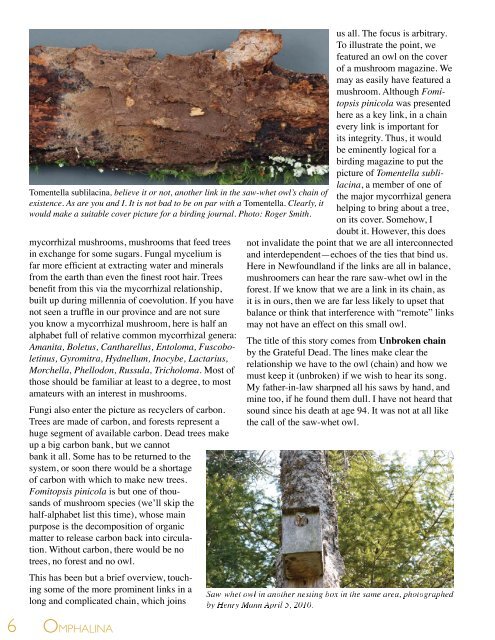My Favourite Mushroom: Coprinus comatus
My Favourite Mushroom: Coprinus comatus
My Favourite Mushroom: Coprinus comatus
Create successful ePaper yourself
Turn your PDF publications into a flip-book with our unique Google optimized e-Paper software.
6<br />
Tomentella sublilacina, believe it or not, another link in the saw-whet owl’s chain of<br />
existence. As are you and I. It is not bad to be on par with a Tomentella. Clearly, it<br />
would make a suitable cover picture for a birding journal. Photo: Roger Smith.<br />
mycorrhizal mushrooms, mushrooms that feed trees<br />
in exchange for some sugars. Fungal mycelium is<br />
far more effi cient at extracting water and minerals<br />
from the earth than even the fi nest root hair. Trees<br />
benefi t from this via the mycorrhizal relationship,<br />
built up during millennia of coevolution. If you have<br />
not seen a truffl e in our province and are not sure<br />
you know a mycorrhizal mushroom, here is half an<br />
alphabet full of relative common mycorrhizal genera:<br />
Amanita, Boletus, Cantharellus, Entoloma, Fuscoboletinus,<br />
Gyromitra, Hydnellum, Inocybe, Lactarius,<br />
Morchella, Phellodon, Russula, Tricholoma. Most of<br />
those should be familiar at least to a degree, to most<br />
amateurs with an interest in mushrooms.<br />
Fungi also enter the picture as recyclers of carbon.<br />
Trees are made of carbon, and forests represent a<br />
huge segment of available carbon. Dead trees make<br />
up a big carbon bank, but we cannot<br />
bank it all. Some has to be returned to the<br />
system, or soon there would be a shortage<br />
of carbon with which to make new trees.<br />
Fomitopsis pinicola is but one of thousands<br />
of mushroom species (we’ll skip the<br />
half-alphabet list this time), whose main<br />
purpose is the decomposition of organic<br />
matter to release carbon back into circulation.<br />
Without carbon, there would be no<br />
trees, no forest and no owl.<br />
This has been but a brief overview, touching<br />
some of the more prominent links in a<br />
long and complicated chain, which joins<br />
OMPHALINA<br />
us all. The focus is arbitrary.<br />
To illustrate the point, we<br />
featured an owl on the cover<br />
of a mushroom magazine. We<br />
may as easily have featured a<br />
mushroom. Although Fomitopsis<br />
pinicola was presented<br />
here as a key link, in a chain<br />
every link is important for<br />
its integrity. Thus, it would<br />
be eminently logical for a<br />
birding magazine to put the<br />
picture of Tomentella sublilacina,<br />
a member of one of<br />
the major mycorrhizal genera<br />
helping to bring about a tree,<br />
on its cover. Somehow, I<br />
doubt it. However, this does<br />
not invalidate the point that we are all interconnected<br />
and interdependent—echoes of the ties that bind us.<br />
Here in Newfoundland if the links are all in balance,<br />
mushroomers can hear the rare saw-whet owl in the<br />
forest. If we know that we are a link in its chain, as<br />
it is in ours, then we are far less likely to upset that<br />
balance or think that interference with “remote” links<br />
may not have an effect on this small owl.<br />
The title of this story comes from Unbroken chain<br />
by the Grateful Dead. The lines make clear the<br />
relationship we have to the owl (chain) and how we<br />
must keep it (unbroken) if we wish to hear its song.<br />
<strong>My</strong> father-in-law sharpned all his saws by hand, and<br />
mine too, if he found them dull. I have not heard that<br />
sound since his death at age 94. It was not at all like<br />
the call of the saw-whet owl.

















